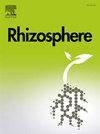Root halotropism in plants: tolerance or escape?
IF 3.4
3区 生物学
Q1 PLANT SCIENCES
引用次数: 0
Abstract
Natural world is composed of fascinating diversity of life-forms and numerous adaptation strategies in the changing environment especially in the plant kingdom. An adaptive plant root response in saline environment to circumnavigate a stressful atmosphere by a directional growth away from salinity is known as halotropism, which is accomplished by the redistribution of phytohormone auxin at the root tip by PIN-FORMED 2 (PIN2) auxin efflux carrier. In this article, we review the role of salt-induced phospholipase D activity, endocytosis of auxin efflux carrier in cell membrane, asymmetry of auxin distribution, ABCB transporters, protein phosphatase 2A, auxin metabolism, phytohormones, microtubule and cell wall glycoprotein in the regulation of root halotropism. As climate change and increased soil salinity are two most important causal factors behind reduction in yield and crop diversity threatening global agriculture, we have summarized key advances in root halotropism and emphasized the importance of gaining a comprehensive understanding on the mechanism of root halotropism in crop plants, which might enable in designing plants with modulated root architecture to enhance crop adaptability and yield in saline soil for ensuring food security across the globe.
求助全文
约1分钟内获得全文
求助全文
来源期刊

Rhizosphere
Agricultural and Biological Sciences-Agronomy and Crop Science
CiteScore
5.70
自引率
8.10%
发文量
155
审稿时长
29 days
期刊介绍:
Rhizosphere aims to advance the frontier of our understanding of plant-soil interactions. Rhizosphere is a multidisciplinary journal that publishes research on the interactions between plant roots, soil organisms, nutrients, and water. Except carbon fixation by photosynthesis, plants obtain all other elements primarily from soil through roots.
We are beginning to understand how communications at the rhizosphere, with soil organisms and other plant species, affect root exudates and nutrient uptake. This rapidly evolving subject utilizes molecular biology and genomic tools, food web or community structure manipulations, high performance liquid chromatography, isotopic analysis, diverse spectroscopic analytics, tomography and other microscopy, complex statistical and modeling tools.
 求助内容:
求助内容: 应助结果提醒方式:
应助结果提醒方式:


